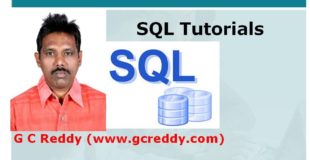http://www.gcreddy.com/2016/07/introduction-to-sql.html Structured Query Language Commands and Operations, What is SQL?, Purpose of SQL, Who Should …
Original source
SQL Tutorial 1: Introduction to SQL


http://www.gcreddy.com/2016/07/introduction-to-sql.html Structured Query Language Commands and Operations, What is SQL?, Purpose of SQL, Who Should …
Original source
33 responses to “SQL Tutorial 1: Introduction to SQL”
Class Notes:
Introduction to SQL (Structured Query Language)
1) What is SQL?
2) Purpose of SQL
3) Who should learn SQL?
4) What are the subsets of SQL?
5) Data Definition Language
6) Data Manipulation Language
7) Data Control Language
——————————————
1) What is SQL?
> SQL stands for Structured Query Language
> SQL was initially developed at IBM in 1970s
> SQL is the standard language to communicate with relational database management systems like
Oracle, MS Access, MS SQL Server, MySQL, DB2, Sybase Etc…
—————————————————-
2) Purpose of SQL
> SQL is used to Create New Databases
> SQL is used to Create New Tables in a Database
> SQL is used to Insert records in a Database
> SQL is used to Update records in a Database
> SQL is used to Delete records in a Database
> SQL is used to Retrieve data from a Database
> SQL is used to execute queries against a Database
> SQL can set permissions on tables, procedures and views
> SQL is used to Create stored procedures in a Database
> SQL is used to Create views in a Database
———————————————————
3) Who should learn SQL?
i) Database Developers
> Design and deploy Database table structures, forms, reports and queries etc…
ii) Database Administrators (DBA)
> Keeping databases up to date and managing database access
> Writing Reports, documentation and operating manuals
iii) Database Testers
> Verify Data Integrity
> Verify Data Manipulations (Add, Update and Delete)
> Verify Data comparisons
——————————————-
4) What are the subsets of SQL?
SQL Commands can be classified in to groups based on their nature, they are,
i) Data Definition Language
ii) Data Manipulation Language
iii) Data Control Language
——————————————————
5) Data Definition Language
Important Commands and Operations in Data Definition Language
i) Create: To create databases and database objects
ii) Alter: To modify existing database objects
iii) Drop: To drop databases and databases objects
iv) Truncate: To remove all records from a table
v) Rename: To rename database objects
———————————————————-
6) Data Manipulation Language
Important Commands and Operations in Data Manipulation Language
i) Select: To select specific data from a database
ii) Insert: To insert new records in a table
iii) Update: To update existing records
iv) Delete: To delete existing records from a table
——————————————————–
7) Data Control Language
Important Commands and Operations in Data Control Language
i) Grant: To provide access on the Database objects to the users
ii) Revoke: to remove user access rights to the database objects
iii) Deny: To deny permissions to users.
—————————————————-
Sir i want to join in your institution . Your teaching skill is excellent sir please can you share your institution location .
sir
I HAVE ONE DOUBT
1)WHAT is the use of creating views in databse…..
Sir SQL and sql server are different r not
Is there any types of SQL ?
Thanks again Mr. Reddy. Your YouTube videos are great.
the way u teaching is good sir
Sir explain every word. Like (what is mean by relational and some important word's)
Jai Ballaya sir
How to install sql in PC
Thanks for your reply
Do you know anyone who teaches oracle Pl/SQL online ?
As I want to get certified in that
Excellent Video do you even teach Pl Sql please advise
Thanks for teaching sir
sir what mean by sql Db
thank you sir, excellent teaching. but tell me remaining two tcl,dql sql statments plz
Thank you so much Sir, for the lesson it's very useful and very good explanation.
Good job Sir 🙂 God bless you
Good teaching
Thankyou sir able to understand clearly
Hi sir your videos are really superb especially providing with practical solutions..Request you to add few more videos on group by, subqueries related problems on large datasets thanks
Thank you sir ,excellent teaching .This video greatly help me to understand about SQL
hi sir, there is any another command accept "desc" for table
It's very very nice & gd job sir.. 👍
This video is very useful
gud information sir
Well Hope I M software developer in vfp and I convert to my self in oracle please help me and I some confusing
Speed is very slow. VERY Slow. Don't repeat words.
sir i am daily watch your all video and tray to learn batter of testing and i have many classes attend but not proper learn and don't of practical practice by any institute…. you are best teaching
totally how many class are taken to finish sql sir plz rly, bcz i need some basic knowledge for me to do my job rly sir
i have gone through the selenium and SQL tutorials by GC reddy sir and i am very satisfied by the way he teaches things from basics.
Thank you sir
gd mng sir i am very confuised just now days could you help me sir
how can i use develop mobile apps which language will help me better .
sir can we recovery the data after restoring new database
set the playback speed 1.5x thank me later
I have a table call member and which has FName,DOB columns. I was able to get age from the DOB Now need to get AgeRange field based on following range(0-18,19-30,30-99) for my C# project. How do I achieve this in SQL
"SELECT FName,DOB, TIMESTAMPDIFF(YEAR,DOB,CURDATE()) AS Age,Mobile FROM members"
Please help me .